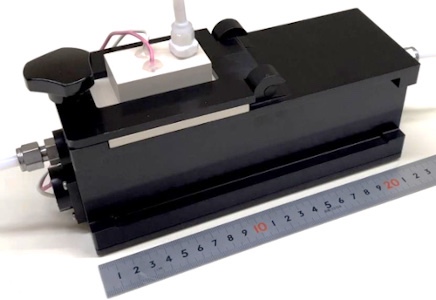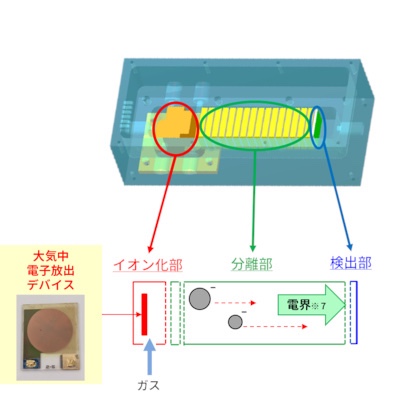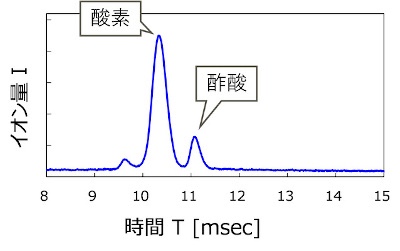


Sharp: Identifies trace gases in the air!
ーDevelopment of Original IMS (Ion Mobility Spectrometry) Analyzerー
sharp:
We have developed an “IMS analyzer for identifying ultra-trace gas components in the atmosphere”.
Equipped with “ionization technology by original atmospheric electron emission device”.
IMS (Ion Mobility Spectrometry):
It is a technology that ionizes gas components in the atmosphere and identifies them based on their speed of movement.
However, in ionization, “using radioactive substances and generating ozone” was a problem.
Conventional analyzer: ‘discharge method’
– Discharge method is the mainstream –
It was limited to very few applications, such as detecting explosives and drugs.
This analyzer: ‘Atmospheric electron emission type’
Originally developed by utilizing the knowledge that we have acquired in the development of MFPs.
Equipped with an atmospheric electron emission device.
Atmospheric electron emission device:
“Stable electron emission, which was conventionally thought to be difficult only in a vacuum,” is realized in the atmosphere.
When ionized components move through the analyzer
“Spectral waveforms of time and amount of ions are compared with the database” to identify components and concentrations.
NEDO projects:
ーParticipating in NEDO’s “Innovative IoT Sensing Technology Development” Projectー
It was confirmed that an ultra-trace component of 0.1 ppb*6 could be detected using an IMS analyzer.
Detects ultra-trace components:
It was also confirmed that “more than 10 different components such as ammonia and acetic acid can be distinguished.”
In the future, we aim to apply it to breath analysis.
https://corporate.jp.sharp/news/230124-b.html
Sharp : Identifie les traces de gaz dans l’air !
ーDéveloppement d’un analyseur original IMS (spectrométrie de mobilité ionique)ー
pointu:
Nous avons développé un “analyseur IMS pour identifier les composants de gaz ultra-traces dans l’atmosphère”.
Équipé de la “technologie d’ionisation par dispositif original d’émission d’électrons atmosphériques”.
IMS (spectrométrie de mobilité ionique) :
C’est une technologie qui ionise les composants gazeux dans l’atmosphère et les identifie en fonction de leur vitesse de déplacement.
Cependant, dans l’ionisation, “l’utilisation de substances radioactives et la génération d’ozone” était un problème.
Analyseur conventionnel : ‘méthode de décharge’
– La méthode de décharge est le courant dominant –
Il était limité à très peu d’applications, telles que la détection d’explosifs et de drogues.
Cet analyseur : “Type d’émission d’électrons atmosphériques”
Développé à l’origine en utilisant les connaissances que nous avons acquises dans le développement de MFP.
Équipé d’un dispositif d’émission d’électrons atmosphériques.
Dispositif d’émission d’électrons atmosphériques :
“L’émission stable d’électrons, que l’on pensait classiquement difficile uniquement dans le vide”, est réalisée dans l’atmosphère.
Lorsque les composants ionisés traversent l’analyseur
“Les formes d’onde spectrales du temps et de la quantité d’ions sont comparées à la base de données” pour identifier les composants et les concentrations.
Projets NEDO :
ーParticipation au projet “Innovative IoT Sensing Technology Development” de NEDOー
Il a été confirmé qu’une composante ultra-trace de 0,1 ppb*6 pouvait être détectée à l’aide d’un analyseur IMS.
Détecte les composants ultra-traces :
Il a également été confirmé que “plus de 10 composants différents tels que l’ammoniac et l’acide acétique peuvent être distingués”.
À l’avenir, nous visons à l’appliquer à l’analyse de l’haleine.
Sharp: Identifiziert Spurengase in der Luft!
ーEntwicklung des Original-IMS-Analysators (Ionenmobilitätsspektrometrie)ー
scharf:
Wir haben einen „IMS-Analysator zur Bestimmung von Ultraspurengaskomponenten in der Atmosphäre“ entwickelt.
Ausgestattet mit “Ionisationstechnologie durch originales atmosphärisches Elektronenemissionsgerät”.
IMS (Ionenmobilitätsspektrometrie):
Es ist eine Technologie, die Gasbestandteile in der Atmosphäre ionisiert und anhand ihrer Bewegungsgeschwindigkeit identifiziert.
Bei der Ionisierung sei jedoch die „Verwendung radioaktiver Substanzen und die Erzeugung von Ozon“ ein Problem.
Herkömmlicher Analysator: „Entladungsmethode“
– Entladungsmethode ist der Mainstream –
Es war auf sehr wenige Anwendungen beschränkt, wie zum Beispiel das Aufspüren von Sprengstoffen und Drogen.
Dieser Analysator: ‘Atmosphärischer Elektronenemissionstyp’
Ursprünglich entwickelt durch Nutzung des Wissens, das wir uns bei der Entwicklung von MFPs angeeignet haben.
Ausgestattet mit einem atmosphärischen Elektronenemissionsgerät.
Atmosphärisches Elektronenemissionsgerät:
„Stabile Elektronenemission, die herkömmlicherweise nur im Vakuum als schwierig galt“, wird in der Atmosphäre realisiert.
Wenn sich ionisierte Komponenten durch den Analysator bewegen
“Spektralwellenformen von Zeit und Menge von Ionen werden mit der Datenbank verglichen”, um Komponenten und Konzentrationen zu identifizieren.
NEDO-Projekte:
ーBeteiligung am Projekt „Innovative IoT Sensing Technology Development“ von NEDO
Es wurde bestätigt, dass eine Ultraspurenkomponente von 0,1 ppb*6 mit einem IMS-Analysator nachgewiesen werden konnte.
Erkennt Ultraspurenkomponenten:
Es wurde auch bestätigt, dass “mehr als 10 verschiedene Komponenten wie Ammoniak und Essigsäure unterschieden werden können”.
In Zukunft wollen wir es auf die Atemanalyse anwenden.